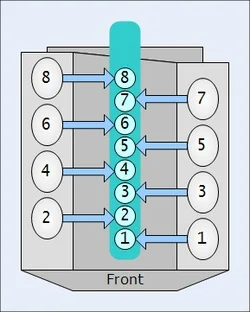Your 5.7 Hemi engine operates with a firing order of 1-8-4-3-6-5-7-2. This sequence maximizes engine performance and is implemented in various Dodge, Jeep, and Chrysler vehicles. This specific method is a distributorless system, employing individual coils for every spark plug.

It’s critical to note that numbering of the cylinders on the driver’s side is 1-3-5-7 and on the passenger’s side it’s 2-4-6-8. Understanding this precise configuration serves as a keen insight into the engine’s advanced ignition system technologies. Continue exploring for a more comprehensive grasp of the 5.7 Hemi engine’s prowess and technicalities.
Quick Navigation
Key Takeaways
- The firing order for a 5.7 Hemi engine is 1-8-4-3-6-5-7-2.
- The cylinder numbering is 1-3-5-7 on the driver’s side and 2-4-6-8 on the passenger’s side.
- This firing order boosts engine performance and utilizes advanced ignition system technologies.
- The 5.7 Hemi engine is a distributorless system with an individual coil for each spark plug.
- Diagrams of the 5.7 Hemi firing order can aid in understanding the engine’s operation and maintenance requirements.
Understanding the Hemi Firing Order

Diving into the intricacies of the Hemi firing order, you’ll find that the sequence is 1-8-4-3-6-5-7-2, with the cylinders numbered as 1-3-5-7 on the driver’s side and 2-4-6-8 on the passenger’s side. This specific arrangement boosts engine performance, delivering power smoothly and efficiently.
The Hemi utilizes advanced ignition system technologies to achieve this. Rather than a distributor, it employs a distributorless system where each spark plug gets its own coil. This setup reduces the chance of misfiring, enhancing the engine’s reliability and performance. The engine’s computer controls the timing, ensuring precision and consistency.
Understanding this firing order and ignition system can help you appreciate how the Hemi maximizes performance and efficiency.
Vehicular Use of Similar Firing Orders
Now that you understand the mechanics of the Hemi firing order, let’s explore how this sequence is utilized in different vehicles. In a comparative analysis, vehicles like Dodge Ram 1500 trucks, Dodge Durango SUVs, and Jeep Grand Cherokee SUVs all incorporate this firing order. It’s also present in Chrysler 300 and Dodge Charger sedans.
The Hemi’s firing order contributes to the engine’s power, torque, and smooth operation, which are key performance benchmarks. This sequence optimizes engine balance, reducing vibration and enhancing performance. It’s interesting to note that this unique order promotes efficiency and power in a wide variety of vehicle models, demonstrating its versatility and importance in automotive engineering.
Evaluating the 5.7 Hemi Engine
In evaluating the 5.7 Hemi engine, you’ll find it garners positive reviews for its power, torque, and smooth operation. As part of the pros, its high torque output and smooth operation make it a favorite for performance enthusiasts.
However, the cons include a reputation for low fuel efficiency. Moreover, a longevity evaluation reveals a lifespan that can exceed 200,000 miles with regular maintenance, giving it a solid reliability rating.
This engine’s versatility across various vehicle types, including trucks and SUVs, highlights its performance capabilities. Nonetheless, concerns over its fuel consumption and emission levels can’t be overlooked.
Horsepower of a 5.7 Hemi
When considering the horsepower of a 5.7 Hemi engine, you’ll find that it typically ranges between 345 and 395, depending on the vehicle and model year. This variation in horsepower can significantly impact the 5.7 Hemi’s performance.
For best 5.7 Hemi horsepower performance, regular maintenance is key. This could range from regular oil changes, spark plug replacements, and ensuring that the engine’s cooling system is functioning at its best. These maintenance tips not only guarantee peak performance but also contribute to the engine’s longevity.
Understanding the horsepower of your 5.7 Hemi is essential; it informs you about your engine’s capabilities, ultimately helping you make the most of your vehicle’s performance. Remember, the horsepower value isn’t just a number, it’s a reflection of your engine’s potential.
Vehicles With 5.7 Hemi Engine
Understanding the horsepower of your 5.7 Hemi engine helps you maximize its potential, and knowing which vehicles utilize this engine can further improve your understanding. The 5.7 Hemi engine is renowned for its performance benefits and long-term reliability. It’s found in a variety of vehicles including:
| Vehicle | Engine |
|---|---|
| Dodge Ram 1500 | 5.7 Hemi Engine |
| Dodge Durango | 5.7 Hemi Engine |
| Jeep Grand Cherokee | 5.7 Hemi Engine |
These vehicles capitalize on the horsepower of the 5.7 Hemi engine, offering powerful performance and durability. The engine is not just about power; it also provides reliable service over the long term. So, whether you’re in a Dodge Ram 1500, a Dodge Durango, or a Jeep Grand Cherokee, you’re experiencing the power and reliability of the 5.7 Hemi engine.
Dissecting the Distributorless Ignition System
Diving into the core of the 5.7 Hemi engine, you’ll find a distributorless ignition system that plays a crucial role in the engine’s performance and efficiency. This system, void of a traditional distributor, uses ignition coils to manage spark timing for each cylinder.
In exploring engine efficiency, it’s important to understand how this system optimizes fuel combustion. The ignition system components communicate with the engine’s computer, which precisely controls the timing of the spark. This guarantees efficient combustion and reduces misfires, hence improving fuel economy and reducing emissions.
The absence of a mechanical distributor also eliminates potential failure points, increasing reliability. Therefore, the distributorless ignition system in the 5.7 Hemi engine is key to its performance and efficiency.
Torque Specifications in Depth
To get the most out of your 5.7 Hemi engine, it’s essential to grasp the torque specifications of its various components. When exploring performance, understanding specifications is vital.
For instance, the cylinder head bolts need to be tightened to 25 Nm initially, then turned an additional 90 degrees. This guarantees top-notch sealing of the combustion chamber.
The main bearing bolts require a torque of 60 Nm, plus an extra 90 degrees. This secures the crankshaft firmly in place, helping to deliver the engine’s impressive power.
The connecting rod nuts need a torque of 27.5 Nm, plus 90 degrees. These specifications ensure the longevity of your engine while maintaining top-tier performance.
Cylinder Numbering Explained
Understanding the cylinder numbering of the 5.7 Hemi engine can help you better grasp the firing order and its impact on the engine’s performance. The engine layout splits the eight cylinders into two groups, with cylinders 1-3-5-7 on the driver’s side and 2-4-6-8 on the passenger’s. This isn’t critical – it’s designed to optimize the engine’s balance and minimize vibrations.
Each cylinder corresponds to a specific spark plug, responsible for igniting the fuel-air mixture, driving the piston down, and generating power. The firing order (1-8-4-3-6-5-7-2) ensures smooth and efficient operation. Misunderstanding this order can lead to issues with spark plug wiring, causing poor engine performance.
Hence, getting a handle on the cylinder numbering is essential for maintaining your 5.7 Hemi engine.
Conclusion
So, knowledgeable speedsters, you’ve risen through the specifics of the 5.7 Hemi’s firing order, revved up your knowledge on related vehicles, and delved deep into the distributorless ignition system.
You’ve welcomed the engine’s energy, harnessed the horsepower, and navigated the numbers of cylinder nomenclature. Tune in to this torque talk and fuel your passion for peak performance.
Remember, understanding your engine lifts your expertise and enriches your driving experience. Drive on, daredevils, with this detailed, dynamic data!

